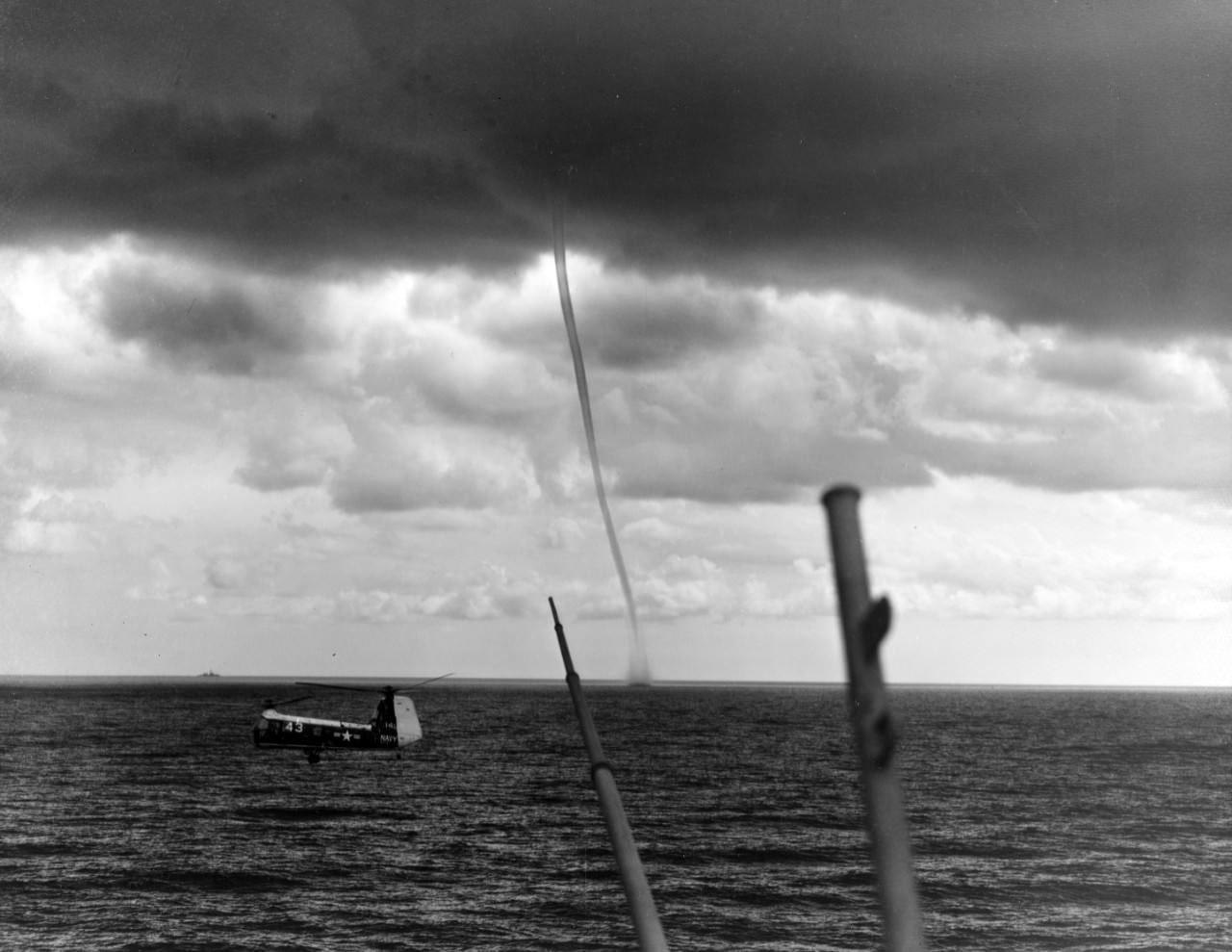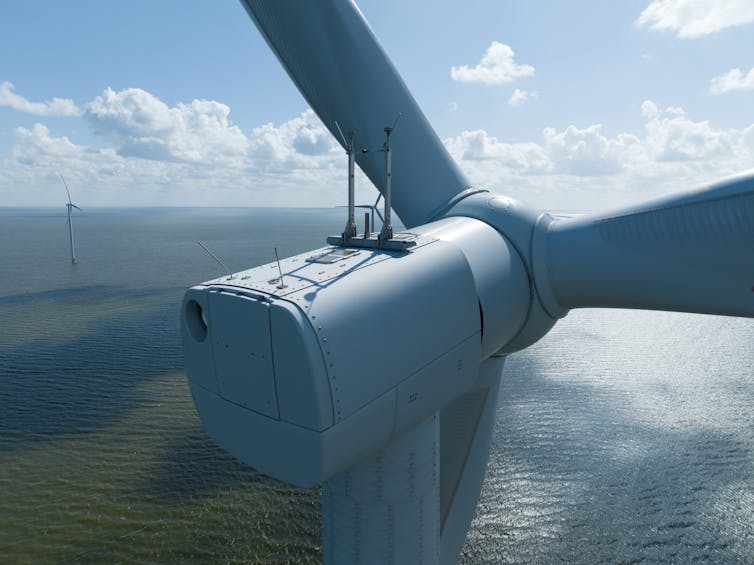Super Typhoon Fung-Wong Makes Philippine Landfall
By Neil Jerome Morales Nov 9, 2025 (Bloomberg) –Super typhoon Fung-Wong hit the Philippines’ northeast late on Sunday with 185 kilometers per hour (115 miles per hour) winds and gusts of...

In the wake of Hurricane Milton, videos of tornadoes and waterspouts flooded social media. We have to ask: Which is more dangerous?
by Astrid Werkmeister (University of Strathclyde) After weeks of intense heatwaves and high sea temperatures, a freak storm off the coast of Sicily sunk a British-flagged yacht named the Bayesian early on Monday August 19. At the time of writing, several people are thought to have been killed or are missing.
The storm is believed to have spawned a “tornadic waterspout” that struck and capsized the vessel. What are these, and are they a symptom of a warming world? We asked Astrid Werkmeister, an atmospheric physicist at the University of Strathclyde who uses satellites to track weather from space.
A waterspout is a column of rotating air that forms over a body of water, typically extending from a cumulus (fluffy and white, like wads of cotton wool) or cumulonimbus (thunderstorm) cloud down to the water’s surface. It closely resembles a tornado, but occurs over water rather than land.
Waterspouts are most common in the tropics and subtropics. There are two main types: fair-weather waterspouts, which develop in relatively calm weather with little wind shear (meaning, little variation in wind speed and direction at different heights in the atmosphere, allowing the waterspout to form more easily); and tornadic waterspouts, which form under the same severe weather conditions that produce tornadoes.
Also read: Incredible Photos and Video of Massive Louisiana Waterspout
Fair-weather waterspouts are generally weaker, whereas tornadic waterspouts are capable of significant damage, particularly if they move onto land. This latter type is what probably caused the Bayesian yacht to sink.
Waterspouts are relatively common in the Mediterranean Sea, particularly around the coasts of Italy and Sicily and especially during late summer and early autumn when sea surface temperatures peak. Warm and relatively calm water combined with localised thunderstorms create ideal conditions for waterspouts to form.
A study analysed (mostly fair-weather) waterspouts near the Balaeric Islands and found that they are most common between 8am and 10am. This is when the rising sun warms air at the surface of the sea, causing it to rise and form clouds that may generate a waterspout. Warm water is critical to the formation of waterspouts as it provides the necessary heat and moisture to fuel this rising air.
Tornadoes form out of thunderstorms, which rely on an unstable atmosphere with high temperatures below and low temperatures above. The bigger the difference between the two air masses, the faster air moves to the top, causing circulation that can generate a tornado – or tornadic waterspout.
Studies have shown that the occurrence and strength of waterspouts is closely related to sea surface temperature. Italian scientists have said that, after successive heatwaves, sea temperatures around Sicily were around 30°C on the day of the storm, which is three degrees higher than average.
The waters around the southern Italian island of Sicily are already known for their susceptibility to waterspouts, and this risk may grow as the climate warms.
While waterspouts and tornadoes both involve rotating columns of air, there are important differences in how they form, their environment and behaviour.
Tornadoes typically form over land and are most often associated with severe thunderstorms known as supercells, which have strong rotating updrafts called mesocyclones. These conditions involve significant wind shear, which is what makes tornadoes so powerful. According to the Fujita scale that measures tornadoes from F0 (very light damage, if any) to F5 (catastrophic), wind speeds exceeding 500 km/h (310mph) are possible.
Waterspouts form over warm bodies of water (lakes as well as the ocean). Fair-weather waterspouts are thankfully more common and often form from cumulus clouds. No storm is necessary so long as you have rising air from a warm water surface that can be spun by horizontal winds. Wind speeds for fair-weather waterspouts range from 80 km/h to 200 km/h (50mph to 125mph) – significantly weaker than most tornadoes.
Fair-weather waterspouts are usually short-lived and rarely dangerous, though small boats and swimmers should beware, especially if they remain over water.
Tornadic waterspouts, however, are more intense and, like tornadoes, form within severe thunderstorms over water or move from land to water. Depending on where they appear, tornadic waterspouts can be just as destructive as land-based tornadoes as they produce similar wind speeds.
One of my research projects involves monitoring conditions at offshore wind farms using satellite technology, buoys and weather models. Waterspouts are one of the more significant hazards to wind turbines and other maritime structures, especially in subtropical regions such as the Mediterranean.
Waterspouts can cause structural damage to wind turbines, particularly the blades and towers, with intense, erratic winds and by hurling debris. Tornadic waterspouts can put turbines out of action and make costly repairs necessary.
While fair-weather waterspouts are less likely to cause significant harm, they can still pose a risk, especially if they directly hit turbines. Waterspouts can threaten workers at offshore wind turbines too, particularly due to their sudden onset and strong winds which can sweep them into the water.
Safety protocols require workers to evacuate or seek shelter well before a waterspout approaches, but if caught off guard, the situation can be life-threatening. This is what caused the recent tragedy, as the waterspout struck the Bayesian yacht in the dark and while most passengers were probably sleeping.
Also read: Waterspout Causes Liftboat to Capsize Off Louisiana Coast
Yes and no. While research has shown that the ocean is warming, and there is a link between the occurrence of waterspouts and sea surface temperatures, a specific connection between waterspouts and climate change has not been extensively studied.
As global temperatures rise as a result of burning fossil fuels, sea surface temperatures are also increasing, providing more energy and moisture to the atmosphere – essential ingredients for waterspout formation.
Most research in this area has been concerned with tornadoes and tornadic waterspouts, as they tend to do the most damage. As human activities increasingly extend into marine and coastal areas, people and waterspouts are coming into more frequent contact, highlighting the need for more research on this topic.

Waterspouts are more likely to form in regions of the ocean with typically high sea surface temperatures, humidity and localised weather systems like sea breezes, small-scale thunderstorms, or convergence zones that make ideal conditions for waterspouts.
Especially during late summer and early autumn, the Mediterranean is known for frequent waterspouts due to its warm waters and dynamic atmospheric conditions that promote development of storms. I remember seeing waterspouts (maybe even tornadic waterspouts) off the coast of Sicily in 2009 during flooding in and around Catania.
The Florida Keys and the Bahamas also see a high number of waterspouts during the warm season. I saw waterspouts here myself, when I lived in Miami. Likewise, the Gulf of Mexico is another hot-spot where waterspouts regularly occur, driven by warm waters and favourable weather systems.
Read next: The Deadliest Catch Is About To Get Deadlier As Arctic Thunderstorms Are Predicted To Intensify

Don’t have time to read about climate change as much as you’d like?
Get our award-winning weekly roundup in your inbox instead. Every Wednesday, The Conversation’s environment editor writes Imagine, a short email that goes a little deeper into just one climate issue. Join the 35,000+ readers who’ve subscribed so far.
Astrid Werkmeister, Knowledge Exchange Associate in Satellite Applications for Sustainable Development, University of Strathclyde
This article is republished from The Conversation under a Creative Commons license. Read the original article.

Sign up for gCaptain’s newsletter and never miss an update

Subscribe to gCaptain Daily and stay informed with the latest global maritime and offshore news
Essential news coupled with the finest maritime content sourced from across the globe.
Sign Up